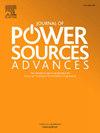A sustainable delamination approach for simultaneous separation and leaching of cathodes from end-of-life Li ion batteries
IF 4.6
Q2 CHEMISTRY, PHYSICAL
引用次数: 0
Abstract
The increasing demand for Lithium-ion batteries (LIBs) in several applications has led to a substantial rise in their production, posing risks in the supply of critical raw materials (CRM, e.g.: Li, Ni, Co). Additionally, improper disposal of end-of-life batteries can lead to environmental pollution and loss of technological value stressing the necessity for sustainable recycling. Current methods involve shredding batteries into a black mass, further processed via pyrometallurgy (energy-intensive) and/or hydrometallurgy with inorganic acids (environmentally hazardous) to recover CRMs. A more refined approach to LIBs recycling includes the dismantling and the sorting of their components, allowing for a targeted extraction.
The spent cathodes recycling process here presented involves the simultaneous delamination from the current collector and the leaching (>95 %) of the cathode active material (CAM) in a citric acid solution, enabling also the recovery of Polyvinylidene fluoride (PVDF) and Carbon filler as unleached residues, which can be used as a composite binder for new electrodes manufacturing. Lastly, metals are recovered with high yields (>85 %) as precursors, used to resynthesise fresh CAM and close the recycling loop. To validate the proposed strategy, the recycled CAM was used in a new cathode manufacturing followed by its functional characterization in a half-cell configuration, achieving high coulombic efficiencies (>99.2 %) and satisfying specific capacities upon cycling (initial capacity: 115 mAh g−1).

从寿命终止的锂离子电池中同时分离和浸出阴极的可持续分层方法
锂离子电池(lib)在一些应用领域的需求不断增加,导致其产量大幅增加,对关键原材料(CRM,例如:Li, Ni, Co)的供应构成风险。此外,对报废电池的不当处理会导致环境污染和技术价值的丧失,这强调了可持续回收的必要性。目前的方法包括将电池粉碎成黑色块,通过火法冶金(能源密集型)和/或无机酸湿法冶金(对环境有害)进一步处理,以回收crm。一种更精细的lib回收方法包括拆卸和分类其成分,允许有针对性的提取。本文介绍的废阴极回收过程包括从集流器中同时分层和在柠檬酸溶液中浸出阴极活性物质(CAM) (> 95%),还可以回收聚偏氟乙烯(PVDF)和碳填料作为未脱出的残留物,它们可以用作制造新电极的复合粘合剂。最后,金属以高收率(> 85%)作为前体回收,用于重新合成新鲜CAM并关闭循环。为了验证所提出的策略,将回收的CAM用于新的阴极制造,然后在半电池配置中对其进行功能表征,获得了高库仑效率(> 99.2%)和循环时满足的特定容量(初始容量:115 mAh g−1)。
本文章由计算机程序翻译,如有差异,请以英文原文为准。
求助全文
约1分钟内获得全文
求助全文

 求助内容:
求助内容: 应助结果提醒方式:
应助结果提醒方式:


